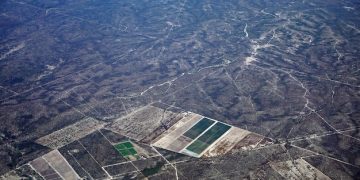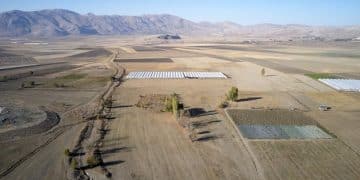National energy policy impact: how it shapes our future

The impact of national energy policy shapes how countries manage energy resources, promotes sustainability through renewable sources, and influences economic growth while addressing climate challenges.
National energy policy impact plays a vital role in shaping our economies and future sustainability. Have you ever wondered how these policies influence your daily life and the environment? Let’s dive into this essential topic.
Understanding national energy policy
Understanding national energy policy is crucial for grasping how our energy systems operate. This policy outlines how a nation manages its energy resources and infrastructure, impacting everything from economic growth to environmental sustainability. By knowing this, citizens can better understand the implications of these decisions on their daily lives.
Every country has its own unique approach to energy policy that can be shaped by various factors including geography, technology, and political climate. For instance, energy policies may prioritize renewable sources over fossil fuels, aiming to reduce carbon emissions and foster clean energy adoption.
Key elements of national energy policy
National energy policies typically consist of several important components:
- Resource Management: This involves the allocation of natural resources such as coal, natural gas, and renewables.
- Infrastructure Development: Building and maintaining energy production and distribution systems.
- Regulatory Framework: Establishing laws and regulations that govern energy production and consumption.
- Environmental Considerations: Policies that address climate change and environmental protection.
In addition, understanding the goals of these policies can help communities adapt to energy transitions. For example, as we shift toward more sustainable energy forms, it is essential for local businesses and consumers to engage with these changes to ensure they benefit from any available resources or incentives.
Moreover, national energy policies often reflect a country’s commitment to international agreements regarding climate change. This can influence how quickly they adopt renewable energy technologies and phase out fossil fuels. These agreements seek to unify global efforts to combat climate change and promote sustainable practices.
The role of innovation in energy policy
Innovation plays a vital role in shaping the future of energy policy. Advances in technology not only improve energy efficiency but also enable the integration of renewable sources into existing energy systems. For example, smart grid technology allows real-time management of energy use, enhancing the reliability and sustainability of energy supply.
Therefore, it’s essential to support research and development in this field. Public and private investments in clean energy technologies could significantly transform national energy landscapes. Engaging stakeholders at all levels can ensure these innovative approaches are effectively implemented and adopted.
In conclusion, by understanding national energy policy, individuals can better engage with and advocate for practices that contribute to sustainable energy futures while adapting to changes that directly affect their lives.
Key components of energy policy impacts

The key components of energy policy impacts greatly influence how policies affect society, the environment, and the economy. To understand these impacts, we must look at several interrelated factors that shape energy production and consumption.
One major component is energy supply. Policies regulate how energy is generated, whether through fossil fuels, nuclear power, or renewable resources. The mix of these energy sources determines not only pricing but also the overall sustainability of the energy supply. Countries are increasingly focusing on expanding renewable energy to meet climate goals.
Economic Effects
The economic effects of energy policies can be significant. Policies can directly impact job creation in the energy sector. For example, strong support for renewable energy can lead to:
- Job Growth: More jobs in solar and wind industries.
- Energy Prices: Stabilized or reduced energy costs due to competition.
- Investment Opportunities: Increased investment in energy technologies.
Furthermore, energy policies can influence consumer behavior. For instance, subsidies for energy-efficient appliances encourage people to reduce energy use. This not only saves money but also lowers overall energy demand.
Environmental Considerations
Environmental impacts of energy policies are equally vital. Effective policies aim to reduce greenhouse gas emissions and protect natural resources. This is particularly important as climate change continues to pose serious threats globally. A shift towards cleaner energy sources is essential for reducing pollution levels.
Moreover, energy policies can affect local ecosystems. For example, the construction of large-scale solar farms can alter land use, impacting flora and fauna. Understanding these environmental impacts is essential for creating balanced policies that meet energy needs while protecting ecological health.
Finally, global energy dynamics also play a role. International agreements like the Paris Accord encourage countries to align their energy policies with global goals. By committing to reduce emissions, nations can work towards a more sustainable energy future.
Case studies of energy policy effects
Case studies of energy policy effects provide valuable insights into how different policies shape energy outcomes. These real-world examples illustrate the successes and challenges faced by nations implementing energy strategies.
One notable case is the transition to renewable energy in Germany. Through its Energy Transition policy, Germany aimed to reduce its reliance on fossil fuels and increase the use of sustainable energy sources. This initiative led to a significant rise in the use of solar and wind energy, drastically cutting greenhouse gas emissions.
Successful Examples
Successful national energy policies often showcase the benefits of investing in renewable energy:
- Job Creation: In Germany, the renewable energy sector has created hundreds of thousands of jobs, boosting local economies.
- Energy Independence: Increased use of local renewable resources reduces dependence on imported fossil fuels.
- Environmental Benefits: Transitioning to cleaner energy sources has improved air quality and public health.
Another example is Denmark, known for its strong wind energy policies. By investing heavily in wind power, Denmark now generates around 47% of its electricity from wind. This remarkable achievement has made the country a global leader in renewable energy production.
Challenges Faced
However, not every case has been smooth. Some policies face challenges that become evident in case studies. For instance, Spain’s early investment in solar energy faced setbacks due to drastic cuts in subsidies that discouraged further development. This raises questions about the sustainability of energy policies and their long-term viability.
Additionally, the U.S. has experienced variations in state-level energy policies, with some states setting aggressive renewable energy goals while others lag behind. This inconsistency leads to disparities in energy production and environmental impact across the country.
These case studies highlight that while energy policies can drive positive change, continuous support and adaptation are necessary to ensure long-term success. They underscore the importance of learning from both the triumphs and setbacks experienced by different nations.
Future trends in energy policy

Future trends in energy policy are increasingly shaped by the urgent need for sustainable solutions. As countries strive to meet climate targets, new policies are emerging that prioritize renewable energy sources and technological advancements.
One major trend is the shift towards decentralized energy systems. This approach allows individuals and communities to generate their own energy through solar panels or wind turbines. As technology becomes more accessible, more households adopt these solutions, reducing reliance on traditional energy grids.
Integration of Smart Technology
The integration of smart technology into energy systems is another significant trend. Smart grids enable real-time monitoring and management of energy usage, which enhances efficiency. Consumers can adjust their energy consumption based on demand, leading to lower costs and reduced waste.
- Demand Response: Programs that incentivize users to lower their energy usage during peak times.
- Energy Storage: Advances in battery technology allow for better storage of renewable energy, making it available even when the sun isn’t shining or the wind isn’t blowing.
- Electric Vehicles (EVs): As more EVs hit the roads, they become part of the energy solution, helping manage grid load.
Moreover, there is an ongoing emphasis on clean energy investments. Governments are increasingly incentivizing investments in solar, wind, and other renewable technologies through tax credits and subsidies. This not only boosts economic growth but also promotes job creation in the energy sector.
Global Cooperation
Another trend is the rise of global cooperation in addressing climate change. International agreements, like the Paris Agreement, push nations to collaborate on emissions reduction and share best practices for sustainable energy development. Sharing technology and resources among countries fosters a more unified approach to achieving energy security.
Furthermore, carbon pricing is gaining popularity as a tool to reduce greenhouse gases. By placing a cost on carbon emissions, it encourages companies and consumers to adopt cleaner energy alternatives.
FAQ – Frequently Asked Questions about National Energy Policy Impact
Why is understanding energy policy important?
Understanding energy policy is crucial because it affects how energy is produced, consumed, and managed, influencing economic growth and environmental sustainability.
What are the key components of energy policy?
Key components include energy supply, infrastructure development, regulatory framework, and environmental considerations.
How does smart technology influence energy policy?
Smart technology helps optimize energy usage and promotes efficiency, allowing consumers to manage their energy consumption better.
What role does renewable energy play in future policies?
Renewable energy is central to future policies as it helps reduce greenhouse gas emissions and dependency on fossil fuels, contributing to a more sustainable energy future.





